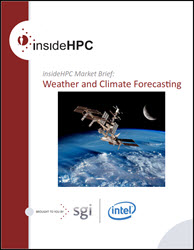The computational requirements for weather forecasting are driven by the need for higher resolution models for more accurate and extended forecasts. In addition, more physics and chemistry processes are included in the models so we can observe the very fine features of weather behavior. These models operate on 3D grids that encompass the globe. The closer the points on the grid are to each other, the more accurate the results. Today most global grid models use a range of 10 to 25 kilometer separation between points; the Holy Grail of weather forecasting is to reduce that separation to one kilometer or less.
Download the insideHPC Special Report on Weather Forecasting and Climate Research
This article is part of a series on HPC’s impact on weather forecasting and climate research.
Technology advancements are making huge amounts of observable data available in preparing the starting point of the numerical simulations. Researchers and forecasters are working with rapidly escalating amounts of data from satellites, buoys, and thousands of other sources detailing various physical and chemical properties. This information comes in a variety of formats that need to be prepared in real time for input into weather models.
For example, think of a tornado, a highly destructive phenomena that can occur in a very small geographic area. If your 3D grid cells span 20km on each side, you might never see the funnel cloud. Or take hurricanes –-if your accuracy is limited to a 200 mile stretch of coastline, it is very difficult to issue well-targeted advisory bulletins and plan evacuations. With finer resolution, lives could be saved and the hundreds of millions of dollars needed to move people and resources could be mitigated.
A threat without the immediacy of a tornado, but a threat nonetheless is El Nino. This is an example of a cyclical climatic phenomena – above average ocean surface water temperature in the equatorial Pacific – that can occur every two to seven year, but can be very strong about every 10 or so years and figures strongly in North American daily winter weather forecasts. Changing weather patterns due to the influence of El Nino include heavy rain, including possible flooding and higher temperatures in California, while the normally soggy Pacific Northwest might experience less rain. The more we understand El Nino’s parameters, the better we can prepare society and services to help minimize damage and the economic impact of the phenomena.
Next week we look at HPC’s impact on climate research. If you prefer, you can download the complete report from the insideHPC White Paper Library courtesy of SGI and Intel.




